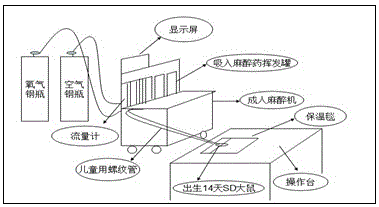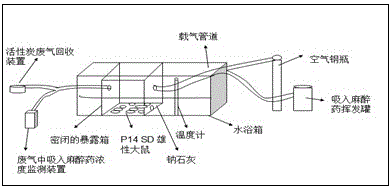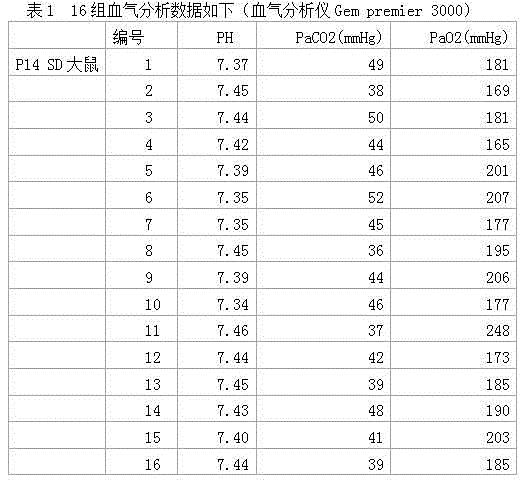Method for managing experimental animal respiration
A management method and experimental technology, applied in the field of experiments, can solve the problem that the influence of neurodevelopment cannot be excluded, and the influence of internal environment disordered neurodevelopment cannot be excluded, so as to reduce the stress response of experimental animals, eliminate traumatic stress, and reduce effect on mortality
- Summary
- Abstract
- Description
- Claims
- Application Information
AI Technical Summary
Problems solved by technology
Method used
Image
Examples
Embodiment 1
[0016] Example 1 An experimental animal respiratory management method
[0017] (1) Induction: Take a male SD rat 14 days after birth, weighing 35g, put it in an induction box, and inject 2% isoflurane into it for inhalational anesthesia induction, until the rat has no body movement, avoid noise and Other animals influence the induction process.
[0018] (2) Intubation:In order to prevent the metal from being too sharp to damage the juvenile animal tissues, tweezers with tape-tipped tweezers were used to provoke the tongue of the rat. If there is no body movement response, the induction is judged to be successful. Two people are required to operate the intubation. Place the rat’s abdomen on the foam board. One person gently fixes the rat’s upper limbs with fingers, and gently presses the rat’s abdomen and hind limbs with the palm of the hand. The other hand takes a small flashlight to shine on the Rat larynx (equivalent to a clinically used laryngoscope), the light can ill...
Embodiment 2
[0022] Example 2 An experimental animal respiratory management method
[0023] (1) Induction: Take a male SD rat 14 days after birth, weighing 33g, put it in an induction box, and inject 3% sevoflurane into it for inhalation anesthesia induction, until the rat has no body movement, avoid noise and Other animals influence the induction process.
[0024] (2) Intubation: In order to prevent the metal from being too sharp to damage the juvenile animal tissues, tweezers with tape-tipped tweezers were used to provoke the tongue of the rat. If there is no body movement response, the induction is judged to be successful. Two people are required to operate the intubation. Place the rat’s abdomen on the foam board. One person gently fixes the rat’s upper limbs with fingers, and gently presses the rat’s abdomen and hind limbs with the palm of the hand. The other hand takes a small flashlight to shine on the Rat larynx, the light can illuminate the glottis through the rat larynx skin...
Embodiment 3
[0028] Example 3 An experimental animal respiratory management method
[0029] (1) Induction: Take a 14-day-old male SD rat, weighing 30g, put it in an induction box, and inject 2% isoflurane into it for inhalation anesthesia induction until the rat has no body movement, avoiding noise and Other animals influence the induction process.
[0030] (2) Intubation: Same as Example 1.
[0031] (3) Mechanical ventilation: Same as Example 1.
[0032] (4) Anesthesia maintenance: Same as Example 1.
[0033] (5) Arterial pressure measurement and blood gas analysis: If the rat needs to perform arterial blood pressure measurement and blood gas analysis after 2 hours of mechanical ventilation, then the rat is moved to the dissecting microscope after 2 hours, and the abdominal aorta is exposed by laparotomy for pressure measurement and blood collection. This process is completed within 90 seconds , and the rats did not move during the operation.
PUM
 Login to View More
Login to View More Abstract
Description
Claims
Application Information
 Login to View More
Login to View More - R&D
- Intellectual Property
- Life Sciences
- Materials
- Tech Scout
- Unparalleled Data Quality
- Higher Quality Content
- 60% Fewer Hallucinations
Browse by: Latest US Patents, China's latest patents, Technical Efficacy Thesaurus, Application Domain, Technology Topic, Popular Technical Reports.
© 2025 PatSnap. All rights reserved.Legal|Privacy policy|Modern Slavery Act Transparency Statement|Sitemap|About US| Contact US: help@patsnap.com



